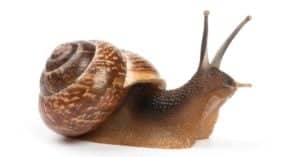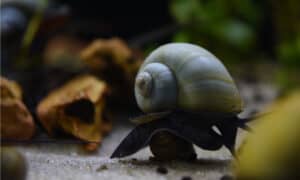Since assassin snails make good pets, you’re probably wondering what their feeding habits are and whether you can have one in your tank. Since they are carnivorous animals, it may be somewhat difficult to find proper supplemental food for them when there’s nothing left in the tank.
Moreover, you should consider what other fish or snails you have in the tank because they may be at risk with these opportunistic feeders.
Check out this article to learn everything about an assassin’s snail diet!
What Are Assassin Snails?
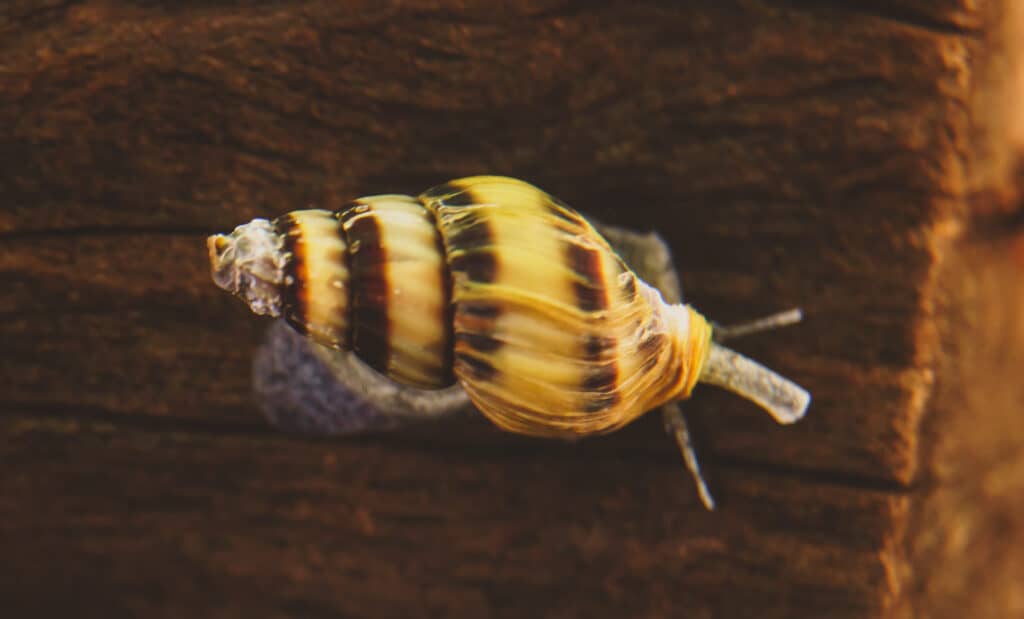
Assassin snails primarily inhabit tropical, freshwater lakes, rivers, and reservoirs.
©iStock.com/M-Production
Assassin snails are freshwater snails called Anentome helena. They are most common in Malaysia, Thailand, and the Indonesian island Sumatra, primarily inhabiting tropical, freshwater lakes, rivers, and reservoirs. Some people call them bumblebee snails.
Nowadays, assassin snails are kept as pets in aquariums, where they prefer muddy or sandy habitats and warm water. They won’t tolerate temperatures lower than 71.6 degrees Fahrenheit and above 82.4 degrees Fahrenheit.
These snails are 0.7 – 1.25 inches long in the wild, but some individuals can reach 3 inches long. They have conical shells with a unique pattern of dark brown and yellowish bands; that’s why people call them bumblebee snails. Some snails may lack yellow stripes and have brown shells. The siphon that comes out of the shell is used for breathing. That’s how they manage to remain buried for longer periods.
These snails have an operculum which they use to block the shell entrance when they feel threatened.
Bumblebee snails spend their time burrowed in sand or mud and come out only to feed, most often during the night.
Their life expectancy is 2-3 years.
What Do Assassin Snails Eat?
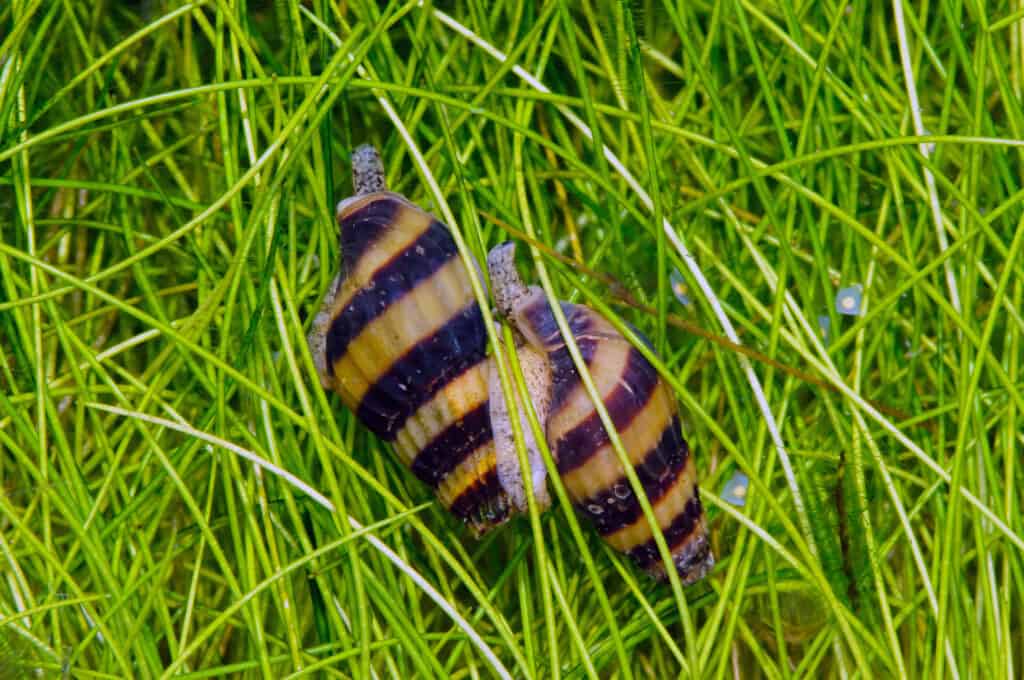
Assassin snails eat worms and other snails.
©iStock.com/corridor91
Assassin snails are carnivorous. However, since they are opportunistic feeders, they will eat whatever they stumble upon.
Assassin snails prefer worms and other snails, which is why they’re called “assassins.” They may even feed on larger snails! Ramshorns and Malaysian trumpets are some of their favorite foods!
Besides snails and worms, assassin snails may “enjoy” dead organisms.
How Often Do Assassin Snails Eat?
Since they spend most of the time buried in sand or mud, assassin snails don’t eat often. One or two snails per day are enough for them.
Do Assassin Snails Eat Algae?
Since assassin snails are carnivorous, they don’t prefer eating algae. Even though they are opportunistic feeders, they’ll turn to algae only if there’s nothing else to eat. They may also like algae wafers since they’re high in protein. So if you were planning to get a snail that would clean the tank, the assassin snail wouldn’t do the job.
However, you can get an assassin snail and another tank mate that would eat the algae. You can go for an Otocinclus catfish, a small fish that lives 3-5 years. It loves feeding on algae! Moreover, it’s very sociable, so your assassin snail won’t get bored. If the tank is large, you should get at least three Otocinclus catfish to cover it. This way, they’ll have more company!
What Should I Feed My Assassin Snail?
In aquariums, assassin snails will definitely delight in pest snails. Snail eggs, brine shrimp, water fleas, bloodworms, or fresh slices of fish or meat can also be fed to them. We recommend feeding them at night when they’re most active.
Do Assassin Snails Make Good Pets?
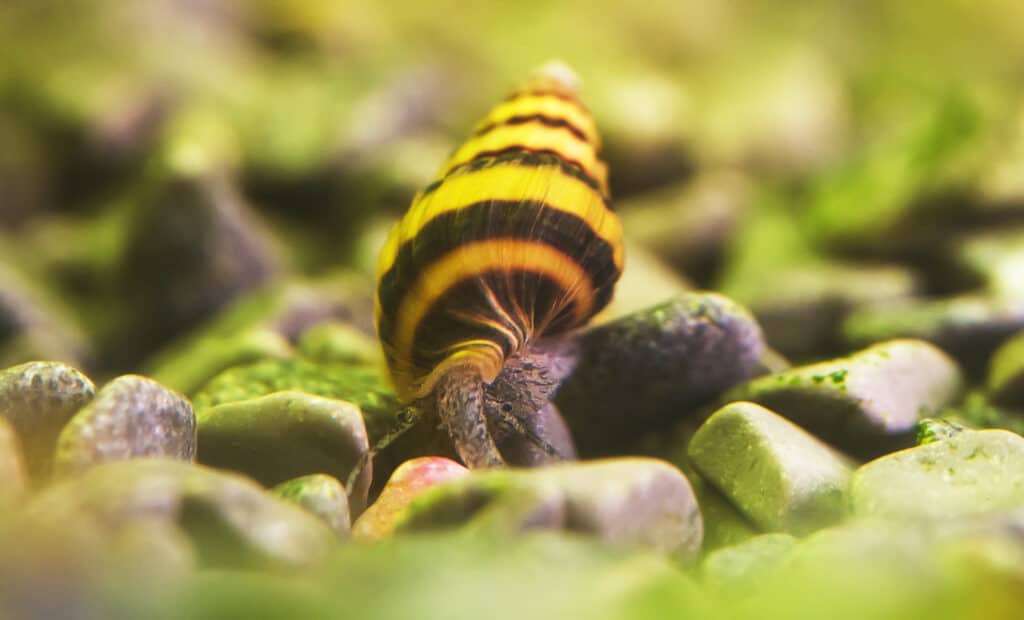
Assassin snails make good pets.
©iStock.com/M-Production
Yes, assassin snails make good pets. They aren’t particularly difficult to care for. The most difficult part is feeding them because you’ll constantly need to get them something they really enjoy eating. Moreover, despite their “terrifying name,” they aren’t dangerous or poisonous to humans.
On the other hand, they are prone to parasites. Anentome helena can get infected with trematode parasites and Echinostoma revolutum. If you buy one, it’s recommended to keep it quarantined for up to four weeks in a smaller tank before putting it into the main tank with other fish. If you notice white spots on the shell and other shell changes, as well as lethargy, it means the snail has a parasitic infection.
Another disease assassin snails may develop is brittle shell, which breaks the shell apart. This is often caused by poor water quality or lack of calcium. When they’re underfed or don’t have enough space, they may experience stunted growth.
What Tank Mates Should I Get for My Assassin Snail?
Even though snails aren’t too active or sociable, they may enjoy some company once in a while.
If you want to buy more fish, you can go for;
- Dwarf suckers
- Freshwater shrimp
- Corydoras
- Killifish
- Dwarf Otocinclus
- Danios
- Cherry barbs
- Freshwater clams
- Tetras.
You can also get more assassin snails in the same tank, as they don’t feed on their own.
You should avoid having other snails in the same tank as assassin snails because the latter may eat them. Only apple snails may be safe – that is, if they’re extra large. You should also avoid buying pufferfish, medium to large catfish, and cichlids.
Incredible Assassin Snail Facts:
- Assassin snails may work together to catch and kill larger prey!
- An assassin snail will attack its prey using its radula, a band located on its jaws.
- Assassin snails cannot be imported into Australia because they can become pests preying on native mollusks. Australia currently has no native carnivorous freshwater gastropods.
Up Next:
- Pet Snails: How To Keep Snails Healthy & Happy
- Snail Terrarium: 8 Tips to Make The Best Snail Habitat
- What Do Snails Eat? Their Diet Explained
The photo featured at the top of this post is © iStock.com/M-Production
Sources
- (1970)
Thank you for reading! Have some feedback for us? Contact the AZ Animals editorial team.



